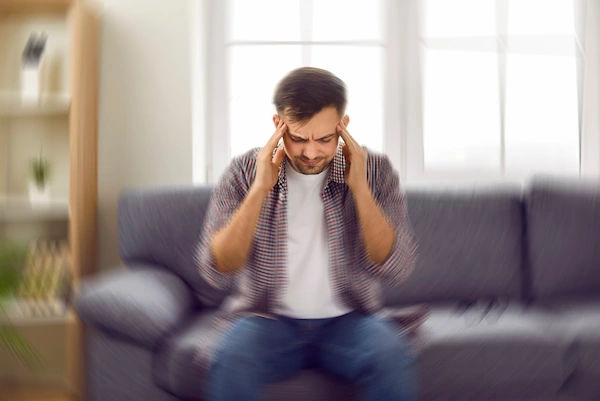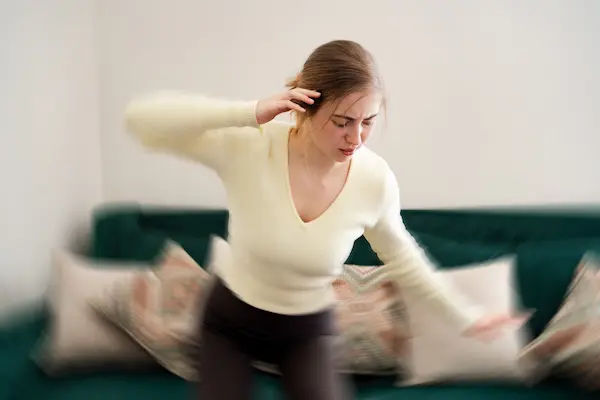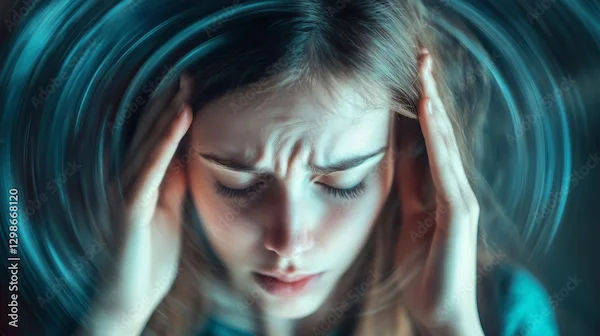What Leads To Signs Of Vertigo ?
Discover the common causes behind vertigo, from inner ear issues like BPPV to migraines. Learn to recognize the signs and when to see a doctor.

.webp?tr=q-80,f-webp,w-350,dpr-2,c-at_max 700w)
Introduction
If the room feels like it’s spinning—or you feel like you’re rocking on a boat while standing still—you’re probably experiencing vertigo. Vertigo isn’t just “feeling dizzy”; it’s a specific sensation of movement when none is happening. It can be terrifying, cause nausea or vomiting, and make walking or even turning in bed a challenge. The good news: most vertigo comes from treatable inner-ear causes, and many people improve quickly with the right steps.
In this friendly, research-backed guide, we explain what leads to signs of vertigo, how to tell it apart from other types of dizziness, the most common causes, when to seek urgent care, and how doctors diagnose and treat it. You’ll learn about proven options like the Epley maneuver, vestibular rehabilitation therapy, and practical home strategies. We’ll also cover special situations (pregnancy, older adults, post-viral vertigo) and share unique tips to help you feel steady again. If symptoms persist beyond two weeks or red flags appear, consider consulting a doctor online with Apollo 24|7 for further evaluation.
Vertigo 101: What it feels like ?(and how it differs from dizziness)
Vertigo is the false sensation that you or your surroundings are moving—most often spinning, tilting, swaying, or rocking—when you’re actually still. Many people describe a sudden spinning attack when rolling over in bed, looking up, or bending down. Others feel a persistent rocking, like being on a boat. Nausea, vomiting, imbalance, and abnormal eye movements called nystagmus commonly accompany vertigo episodes. Importantly, “dizziness” is a broader term that also includes lightheadedness (like you might faint), unsteadiness, or a “swimmy” head; vertigo is a specific subtype characterized by perceived motion.
Common signs and symptoms of vertigo
- Spinning or tilting sensation
- Nausea or vomiting
- Worsens with head movement
- Unsteady gait; difficulty focusing
- Abnormal eye movements (nystagmus), which clinicians use to pinpoint the cause
Peripheral vs central vertigo: why it matters (LSI: peripheral vs central vertigo)
Peripheral vertigo comes from inner-ear (vestibular) issues. It’s far more common and often triggered by head position changes. Examples include benign paroxysmal positional vertigo (BPPV), vestibular neuritis/labyrinthitis, and Meniere’s disease.
Central vertigo arises from problems in the brainstem or cerebellum (e.g., vestibular migraine, stroke, multiple sclerosis). Central causes can be serious and need prompt evaluation.
Unique insight: In the first hours or days of a vertigo attack, your brain tries to “reweight” incoming signals from the ears, eyes, and body. The mismatch makes you feel worse when you move. Gentle, progressive motion—rather than strict bedrest—often helps your brain adapt faster once dangerous causes are ruled out.
Consult a Top General Physician
How does your balance system work?
Feeling steady relies on three information streams: your inner ear balance organs (vestibular system), your eyes, and your body’s position sensors (proprioception). The brain integrates these inputs to keep you upright and your vision stable.
Inner ear (vestibular organs), eyes, and body sensors (LSI: inner ear balance disorders)
Each inner ear contains semicircular canals (detect head rotation) and otolith organs (detect linear acceleration/gravity). Tiny crystals called otoconia help these organs sense motion.
Your eyes stabilize vision via the vestibulo-ocular reflex (VOR): when your head moves, your eyes automatically move the opposite way so the world doesn’t blur.
Proprioceptors in muscles and joints tell the brain where your body is in space.
The brain’s balance center
Brainstem and cerebellum integrate vestibular, visual, and proprioceptive input. If one input is damaged or sends “noise,” you can feel vertigo.
When signals clash, vertigo happens (LSI: otoconia; motion sickness)?
- If otoconia slips into the wrong canal (BPPV), head movements trick the system into thinking you’re spinning.
- Viral inflammation of the vestibular nerve (vestibular neuritis) can cause a sudden, continuous vertigo with nystagmus.
- Visual environments (e.g., scrolling screens, busy supermarkets) can worsen symptoms,
- especially after an inner-ear injury.’
Unique insight: Many people unknowingly “avoid” head and eye movements after an attack. Short, frequent “movement snacks” (slow head turns, gaze stabilization) can train the VOR and restore confidence—ideally guided by a vestibular therapist.
Common inner-ear causes of vertigo
Benign paroxysmal positional vertigo (BPPV) (long-tail: benign paroxysmal positional vertigo)
The most common cause of vertigo, BPPV, produces brief (10–60 seconds) spinning when rolling in bed, looking up, or bending. It happens when otoconia crystals migrate into a semicircular canal.
Diagnosis: The Dix-Hallpike test triggers vertigo and a characteristic nystagmus pattern.
Treatment: Canalith repositioning maneuvers (most famously the Epley maneuver) move crystals back where they belong. Success rates are high, and many people improve in 1–3 sessions.
Epley maneuver and canalith repositioning (long-tail: Epley maneuver step-by-step)
- Evidence: A Cochrane review and clinical guidelines support Epley and similar maneuvers as first-line therapy for posterior canal BPPV.
- Tip: Correct side and canal identification matters; trying online videos can help, but professional guidance avoids common mistakes and speeds recovery.
Vestibular neuritis and labyrinthitis (LSI: vestibular neuritis vs labyrinthitis)
- Often viral, these conditions cause sudden, severe vertigo lasting hours to days, usually with imbalance and nausea. Vestibular neuritis affects the nerve; labyrinthitis also affects hearing (adding tinnitus or hearing loss).
- Treatment includes short-term vestibular suppressants for severe nausea, early mobilization, and vestibular rehabilitation therapy (VRT). Most recover over weeks, but residual unsteadiness can persist without rehab.
Meniere’s disease (LSI: Meniere’s disease attack triggers)
Characterized by episodic vertigo (20 minutes to several hours), fluctuating hearing loss (often low-frequency), tinnitus, and aural fullness due to inner-ear fluid imbalance.
Management may include a low-salt diet, diuretics, trigger control, and, in some cases, procedures. A hearing specialist (ENT) typically co-manages care.
Unique insight: Filming your eye movements (nystagmus) during an attack—using a smartphone in good light—can help your clinician identify the affected canal in BPPV and distinguish peripheral patterns from central ones.
Brain-related causes (central vertigo)
Vestibular migraine (long-tail: vestibular migraine symptoms)
- Common but often underdiagnosed, vestibular migraine can cause vertigo with or without headache. Attacks may last minutes to hours and be triggered by stress, sleep changes, certain foods, or hormonal shifts. Sensitivity to light/sound and a history of motion sickness are common clues.
- Treatment blends migraine management (sleep regularity, stress reduction, trigger identification, preventive meds when needed) with vestibular rehab for persistent imbalance.
Stroke and transient ischemic attack (TIA) (long-tail: HINTS exam stroke vs vertigo)
- Posterior circulation strokes can present with acute severe vertigo, imbalance, new headache, and neurological deficits (double vision, slurred speech, weakness, severe trouble walking). This is an emergency.
- The HINTS bedside exam—when performed by trained clinicians—can help distinguish stroke from vestibular neuritis early and may outperform early MRI in certain settings. [7] If stroke is suspected, immediate imaging and treatment are critical.
Multiple sclerosis and rare tumors
Inflammatory brain lesions or tumors (e.g., acoustic neuroma/vestibular schwannoma) can cause vertigo, often with other progressive neurological or hearing symptoms. These require specialist evaluation and imaging.
Unique insight: If your vertigo comes with a new, persistent headache (especially different from your usual), neck pain after trauma, or a “worst-ever” onset, seek urgent care—even if you’ve had BPPV before. Not all vertigo is the same each time.
Other triggers and look-alikes
Orthostatic hypotension and dehydration (long-tail: orthostatic hypotension dizziness)
Standing up quickly can cause a sudden blood pressure drop and lightheadedness (not true spinning). Dehydration, illness, and some medications make this more likely. Hydration and reviewing meds can help.
Medications that cause dizziness
Sedatives, certain blood pressure drugs, some antibiotics (e.g., gentamicin), antidepressants, and vestibular suppressants (if overused) can worsen imbalance. Review your medication list with a clinician.
- Anxiety, panic, and cervicogenic dizziness (long-tail: cervicogenic dizziness treatment)
- Anxiety can amplify symptoms from an inner-ear event and, in some, become a primary driver through hypervigilance and altered breathing. Targeted breathing, cognitive-behavioral strategies, and graded exposure help.
- Neck disorders may contribute to perceived imbalance (cervicogenic dizziness). Physiotherapy and posture/ergonomic changes can reduce symptoms.
Unique insight: If visual environments (supermarkets, busy patterns, scrolling screens) trigger or worsen symptoms, try “visual diet” breaks, reduce screen motion (settings), and practice brief, structured exposure exercises to retrain tolerance.
Red flags: when vertigo is an emergency
Seek urgent care immediately if you experience:
- Stroke signs: facial droop, arm weakness, slurred speech, severe trouble walking, double vision, new severe headache, or sudden weakness/numbness. Think FAST (Face, Arm, Speech, Time). [
- Sudden hearing loss in one ear: prompt treatment improves outcomes.
- Head injury or neck trauma followed by vertigo.
- New, continuous severe vertigo with inability to stand/walk, especially with risk factors for stroke (age, hypertension, diabetes).
If symptoms persist beyond two weeks or significantly disrupt daily life, consult a doctor online with Apollo 24|7 for evaluation and next steps.
How do doctors diagnose vertigo?
History and physical exam
Clinicians ask about timing, triggers, duration (seconds vs hours), associated symptoms (hearing loss, headache, visual changes), and medication use. Patterns point to likely causes (e.g., seconds-long spinning with rolling in bed suggests BPPV).
- Bedside tests: Dix-Hallpike and HINTS exam (long-tail: Dix-Hallpike test for vertigo)
- Dix-Hallpike test: turning the head and quickly lying back can provoke characteristic nystagmus in posterior canal BPPV.
- HINTS exam (Head-Impulse, Nystagmus, Test-of-Skew): in skilled hands, helps distinguish peripheral from central causes in continuous acute vertigo. A normal head-impulse with direction-changing nystagmus or skew deviation raises concern for stroke.
Imaging and lab tests—when they’re needed
Imaging (MRI) is reserved when central causes are suspected, there are red flags, or hearing asymmetry suggests tumors. Routine imaging isn’t needed for straightforward BPPV.
Labs are not routinely required, but targeted tests may check contributors like anemia or vitamin D status in recurrent BPPV. Apollo 24|7 offers a convenient home collection for tests such as vitamin D if your clinician recommends them.
Unique insight: Keeping a “vertigo diary” (timing, triggers, foods, menstrual cycle, sleep, stress) often reveals patterns—especially for vestibular migraine and Meniere’s disease—and accelerates diagnosis.
Evidence-based treatments and recovery
Canalith repositioning maneuvers (Epley, Semont) (long-tail: canalith repositioning therapy)
First-line for BPPV; they move displaced crystals out of the affected canal. High-quality evidence supports rapid relief and fewer recurrences compared with no treatment. [8,12]
Tips: Wait a few minutes after maneuvers before standing, and avoid vigorous head movement for the rest of the day. If symptoms persist, repeat maneuvers or see a clinician to confirm the correct canal/side.
Medications: what helps—and what doesn’t (long-tail: meclizine side effects)
Short-term relief: antiemetics and vestibular suppressants (e.g., meclizine, benzodiazepines) can ease severe nausea for 1–3 days. They should be minimized after that, as they may slow the brain’s compensation and prolong recovery.
For vestibular migraine, preventive and acute migraine therapies may be used along with lifestyle changes.
- Vestibular rehabilitation therapy (VRT) (long-tail: vestibular rehabilitation therapy exercises)
Tailored exercises retrain gaze stabilization and balance, reduce motion sensitivity, and improve confidence. VRT speeds recovery after vestibular neuritis and helps persistent symptoms after BPPV or concussion. - Unique tip: If you tend to brace your neck or hold your breath when moving, practice relaxed breathing and gentle head motion together—this reduces protective stiffness that perpetuates symptoms.
If your condition does not improve after trying these methods, book a physical visit to a doctor with Apollo 24|7 to explore further options or specialist referral.
Home strategies and prevention tips
Hydration, sleep, and trigger tracking
Dehydration and sleep loss can intensify symptoms. Aim for consistent sleep and regular meals. Track triggers in a diary to spot patterns (especially helpful for vestibular migraine and Meniere’s).
Vitamin D and BPPV recurrence (long-tail: vitamin D deficiency and BPPV recurrence)
Research suggests vitamin D supplementation in people with low levels may reduce BPPV recurrence. One randomized trial found fewer repeat episodes with supplementation in deficient patients. Discuss testing and dosing with your clinician.
Apollo 24|7 offers home collection for vitamin D tests, improving convenience if you have mobility challenges during vertigo.
Fall-proofing and safe movement
- Use night lights, clear clutter, install grab bars if needed, and sit at the bedside for a moment before standing.
- When an attack strikes: keep your gaze on a fixed point, breathe slowly, and avoid sudden head turns until symptoms settle.
Unique insight: “Micro-dosing” motion—two or three sets of 30–60 seconds of gentle head turns and gaze exercises spaced through the day—often works better than a single, exhausting session.
Special situations and living well
Vertigo in pregnancy, children, and older adults
- Pregnancy: posture changes, anemia, and migraine patterns can shift; discuss medication safety with your obstetrician.
- Children: vestibular migraine and otitis media complications are common considerations; pediatric evaluation is key.
- Older adults: polypharmacy and orthostatic hypotension are frequent contributors; review medications and hydration.
Post-viral and post-concussion vertigo (including after COVID-19)
Viral infections can inflame the vestibular nerve, while concussion can disrupt central processing. VRT and gradual activity progression aid recovery; avoid prolonged rest.
Work, travel, and daily life tips
- On planes/cars, sit where motion is least (over the wings/front seat), fix your gaze on the horizon, and minimize screen use.
- For desk work, reduce screen motion settings and take “visual breaks.”
Unique insight: If supermarket aisles trigger symptoms, try slow “head scanning” before you enter, keep your cart as a rolling support, and practice stepping side-to-side while maintaining a soft gaze on items—this retrains visual-vestibular integration.
Consult a Top General Physician
Conclusion
Vertigo can upend your day—sometimes your week—but understanding what leads to signs of vertigo helps you act decisively. Most episodes stem from inner-ear issues like BPPV or vestibular neuritis and respond well to proven treatments, including canalith repositioning maneuvers and vestibular rehabilitation therapy. Central causes like vestibular migraine are manageable with lifestyle adjustments and, when needed, medications. Keep an eye out for red flags (stroke symptoms, sudden hearing loss, significant head or neck trauma) that require urgent attention. Small, daily habits—hydration, sleep regularity, and gentle, graded movement—can speed recovery and reduce recurrences. If your vertigo keeps coming back, or you’re unsure what’s causing it, consult a doctor online with Apollo 24|7; if tests are needed, Apollo 24|7 also offers convenient home collection for labs like vitamin D. With the right plan and support, most people regain confidence and balance—and get back to doing what they love.
Consult a Top General Physician

Dr. Sougata Kumar
General Practitioner
8 Years • MBBS
East Midnapore
VIVEKANANDA SEBA SADAN, East Midnapore

Dr. Abhishek Ranjan
General Practitioner
4 Years • MBBS
Kolkata
VDC Clinic, Kolkata

Dr. Tapabrata Ray
General Physician/ Internal Medicine Specialist
4 Years • MBBS,DGM,CPMeC,ACMDC
Kolkata
MCR SUPER SPECIALITY POLY CLINIC & PATHOLOGY, Kolkata
Dr. Sujay P R
General Physician/ Internal Medicine Specialist
3 Years • MBBS
Bengaluru
PRESTIGE SHANTHINIKETAN - SOCIETY CLINIC, Bengaluru

Dr. Santanu Mandal
General Physician/ Internal Medicine Specialist
17 Years • MD (Physician), DNB (General Medicine)
Kolkata
MCR SUPER SPECIALITY POLY CLINIC & PATHOLOGY, Kolkata
(25+ Patients)
Consult a Top General Physician

Dr. Sougata Kumar
General Practitioner
8 Years • MBBS
East Midnapore
VIVEKANANDA SEBA SADAN, East Midnapore

Dr. Abhishek Ranjan
General Practitioner
4 Years • MBBS
Kolkata
VDC Clinic, Kolkata

Dr. Tapabrata Ray
General Physician/ Internal Medicine Specialist
4 Years • MBBS,DGM,CPMeC,ACMDC
Kolkata
MCR SUPER SPECIALITY POLY CLINIC & PATHOLOGY, Kolkata
Dr. Sujay P R
General Physician/ Internal Medicine Specialist
3 Years • MBBS
Bengaluru
PRESTIGE SHANTHINIKETAN - SOCIETY CLINIC, Bengaluru

Dr. Santanu Mandal
General Physician/ Internal Medicine Specialist
17 Years • MD (Physician), DNB (General Medicine)
Kolkata
MCR SUPER SPECIALITY POLY CLINIC & PATHOLOGY, Kolkata
(25+ Patients)
More articles from Vertigo
Frequently Asked Questions
How do I know if it’s BPPV or something else?
BPPV causes brief spinning (10–60 seconds) with specific head movements like rolling in bed or looking up. The Dix-Hallpike test confirms it. Continuous vertigo, hearing changes, severe headache, or neurological symptoms suggest other causes—get evaluated.
Can anxiety cause vertigo-like symptoms?
Anxiety doesn’t usually cause true spinning but can amplify dizziness and imbalance, especially after an inner-ear event. Breathing techniques, gradual exposure, and, if needed, therapy or medication can help manage anxiety-related dizziness.
Are there exercises to stop vertigo at home?
For BPPV, the Epley maneuver or Brandt-Daroff exercises can help, but correct side identification is key. Vestibular rehabilitation therapy provides individualized exercises for persistent symptoms. If unsure, consult a clinician with Apollo 24|7.
Which medicines help vertigo—and which should I avoid?
Short courses (1–3 days) of antiemetics or vestibular suppressants can reduce severe nausea. Long-term use can slow recovery. For vestibular migraine, migraine-specific treatments are useful. Always review medications with your doctor.
How can I prevent vertigo from coming back?
Stay hydrated, sleep regularly, manage triggers, and keep moving. If you have recurrent BPPV, discuss vitamin D testing and supplementation if deficient, which may lower recurrence risk.


